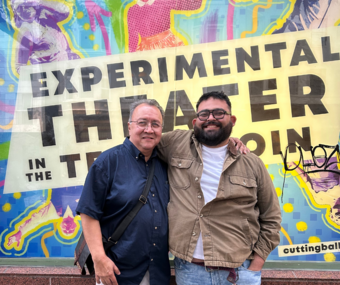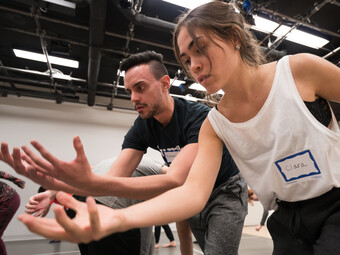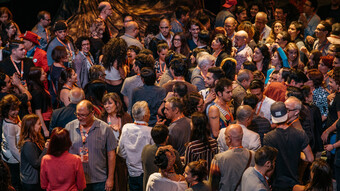Performance Colectiva at CAL
Breaking The Berkeley Bubble, One Performance At A Time
The stage was set. The students were ready. The show was about to begin. After only a few days of blocking and cueing everything to the right music, lighting and scribbling down changes to our scripts, we were ready to begin. For one night and one night only, Bodies, Buildings, Borders: An Experimental Showcase was presented in Spring 2013 by students of the Teatro Lab class taught by recently hired Performance Studies professor, Angela Marino. After a semester exploring theater and performance in Latin America, we decided to share what we had experienced in this showcase that covered: How we see ourselves at the most personal level (bodies), how we fit/ don’t fit in the university and how that affects where we stand in student government elections (buildings), to how migrant issues really come back to student issues as we deal with coming from mixed-status migrant families and the fear of separation (borders).
After the conclusion of this performance, we heard great things from friends and family. It was very clear, we were on to something and we needed more space for students of color performances. Now, some people may ask themselves why students at the University of California, Berkeley need more opportunities and physical space for theater when they can easily explore the Bay Area and its well known progressive politics in order to find a plethora of theaters trying to diversify their casts, productions and audiences.
Well, there is something called the “Berkeley Bubble,” within which students live and which separates them from the city of Berkeley and other communities in the East Bay. With the immense academic pressure students experience at a school like CAL, along with the downright complacency that comes with Berkeley’s reputation as a haven of student protest movements, issues that arise in the surrounding communities are bypassed and, instead, studied from afar in books and ethnographic papers. And while students can ignore issues affecting communities outside of the Berkeley Bubble, issues that arise inside the University are harder to bypass. This is especially true for students of color who are confronted with incidents like a fraternity hanging a stuffed dummy with a black face as part of their Halloween decorations, Berkeley police getting caught on tape harassing, tackling and arresting black students for jaywalking just a few blocks away from campus. Or the selection of Janet Napolitano as president of the University of California system, when as early as a year ago, as Secretary of Homeland Security, she was deporting family members and threatening deportation of students. And while all of these real incidents have taken place on campus, students of color representation has drastically dropped since the removal of Affirmative Action and student-run minority outreach services such as Bridges have subsequently taken the role of the University to recruit and retain students. Even if students of color decide to ignore all of this, they still face staff, professors and peers who constantly question whether they deserve to be at UC Berkeley in the first place.
That is why theater for students of color is needed in the University: to speak about these issues and at the same time, break the Berkeley Bubble by showing that issues students study about in their classes including, race, class and gender have a real impact on campus life. Anyone who has been in theater knows that in order for a production to happen, there must be constant communication and trust; that is the essence of community-building. Theater and performance do something very important: they help share ideas in imaginative ways, create community and allow for dialogue.
In the Fall of 2013, I set out to connect with folks who would be interested in taking part in the creation of a space that could continue the work the Teatro Lab class had begun the previous semester. I was able to connect with people of color from the theater classes I was taking as well as performers I had watched at different multicultural events. This quickly became another purpose for what this group was going to be—to create what professor Marino calls a “performance pipeline” and be a bridge between the Theater, Dance and Performance Studies Department and people who sought out inspiration and a space to create outside of the department. This encourages students of color to take classes in the theater department who would have felt out of place otherwise, such as the Teatro Lab class did for students, myself included.
At the same time, it allows space for students in the department to step out and grapple over how being a person of color affects their work as a performer. Having this purpose in mind, the Performance Colectiva was created as a collective of spoken word artists, actors, dancers, directors, writers, musicians and visual artists.
Over the past year, we have collaborated with other student groups to put on events on campus. We hosted a talk with the president of Rainbow Theater, Brenda Covarrubias and other UC Santa Cruz students who shared their ideas on doing student-run theater on their campus. We hosted a talk with playwright, Octavio Solis on his own experiences as a professional out in the theater world. We’ve also facilitated workshops given to middle school students, incoming freshmen & transfer students on performance, theater and creative writing. This summer supporters of the Performance Colectiva and Teatro Lab will be at the Association for Theater in Higher Education conference in Arizona to connect with others and learn about resources we can bring back to further our efforts. The Colectiva will also be helping with the fiftieth anniversary celebration of Teatro Campesino happening at UC Berkeley this fall.
This fall as well, the Performance Colectiva will launch a performance workshop series called “Breaking The Berkeley Bubble.” By exploring different topics, they will get a sense of what it is like to break away from the expectations of the University and get closer to the kind of work they are passionate about. The goals of the workshops are to present what develops from these workshops as well as go out into the community and see the work being done to address issues through art. Led by the inspiration of other performance workshop series such as “Love Balm Project,” student groups performance spaces like Rainbow Theater at UC Santa Cruz and international collectives such as Quilomboarte based in Mexico, this is an exciting project. We invite everyone who finds this work valuable to participate—whether it be in the form of conversations about integrating art in schools, contributing time or resources to the Performance Colectiva, or simply sharing something you are passionate about with someone new. We all tend to form bubbles within our groups for many reasons, but what would happen if we decided to step out? Surely, there is only one way to find out.










Comments
The article is just the start of the conversation—we want to know what you think about this subject, too! HowlRound is a space for knowledge-sharing, and we welcome spirited, thoughtful, and on-topic dialogue. Find our full comments policy here
I am extremely proud and amazed with this great project; talent, passion, inovation, and intellect shine all around it . To have a united and democratic country we have learned that we cannot depend soley on Physical integration but also on the psychological aspect to allow all communities to intergrate mentally through communal educative projects like this Performane Colectiva. Everyone has potential to excel when given the adequate venues, guidance and opportunities to do so. This project is truly a great example of why its important to diversify our Universities and I aplaud the hard work and dedication of those who go above and beyond to insure a better future for the coming generations.